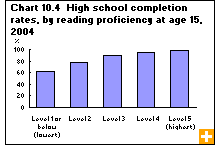Common menu bar links
Reading literacy fosters achievement
Archived Content
Information identified as archived is provided for reference, research or recordkeeping purposes. It is not subject to the Government of Canada Web Standards and has not been altered or updated since it was archived. Please contact us to request a format other than those available.
Reading literacy at the age of 15 plays an important role in completing high school and attending postsecondary institutions. According to 2004 data, youth with good reading literacy are more likely to obtain their high school diploma, while those who have difficulties are more likely to drop out or still be in high school at the age of 19.
Eighty-seven percent of students had graduated from high school at the age of 19. However, only 62% of the students with the lowest reading literacy had finished high school. Almost all students who attained the highest levels of reading literacy had graduated by age 19.
Students who had not pursued postsecondary studies at the age of 19 posted reading literacy results that were, on average, more than one level below the results of those who had gone on to postsecondary studies. In addition, only 28% of youth with the lowest reading literacy level had done some type of postsecondary education.
Reading literacy affects obtaining a high school diploma, even when factors such as sex, mother tongue, parents’ level of education, family income, place of residence, school involvement and social involvement are considered. It also affects participation in postsecondary studies, given the known factors associated with it: sex, mother tongue, parents’ education level and family income.
Neither the quality of reading literacy nor academic qualifications guarantee success in life. However, without them, Canadians face higher risk of encountering barriers to employment, enjoying less financial security and fewer positive social outcomes.



